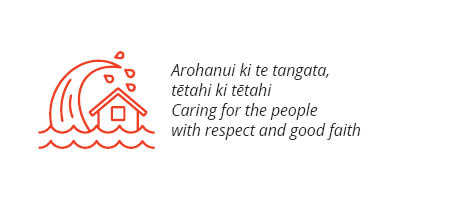Climate Change and Community Resilience | Te Whakamahanatanga o Te Ao Te Aumangea o to Hapori
We protect people, natural and built assets and the regional economy.
 There are five work programmes in this portfolio:
There are five work programmes in this portfolio:
- Leading community resilience
- Managing the coastal environment
- Climate change resilience
- Managing contaminated land, hazardous substances and waste
- Leading flood and river resilience.
Leading community resilience
While it is not possible to keep everyone safe from all hazards, it is possible to mitigate the risks through being well-informed, well-prepared and resilient. Being prepared will help minimise losses and recovery times so that communities are safer, our environment is protected and our economy can continue to operate, protecting jobs and livelihoods.
We collect and communicate natural hazards information to help build resilience and enhance our collective capacity to adapt, respond and recover when emergencies occur.
We are home to the region’s Civil Defence Emergency Management (CDEM) Group, which takes care of the response in the event of a regional emergency. The Group hosts Emergency Operations and Coordination Centres in the Christchurch Justice and Emergency Services Precinct.
Managing the coastal environment
By working with, and alongside, our partners we are managing the regeneration of Canterbury’s coastal environment through effective and integrated coastal management. We monitor for hazards and report on short and long-term shoreline changes and hazards.
The region has two large commercial ports (Whakaraupō/Lyttelton and Timaru). Through the Harbourmaster’s Office we manage port safety, commercial shipping, recreational boating safety and swing moorings. Basically, if you operate any type of vessel on any waterway in the region, we're here to make sure you do it safely.
The Canterbury Regional Coastal Environment Plan is the regulatory framework that protects and safeguards our precious coast.
Climate change resilience
Climate change is a household concern, and as a region, we need to be able to adapt and respond to it and try to mitigate the impact of our actions.
We are building community knowledge and resilience and working with our partners, Papatipu Rūnanga and other councils to share what we know and what we are doing with our communities.
Find out more on the It’s time, Canterbury website.
Managing contaminated land, hazardous substances and waste
Past and sometimes present land practices and industrial activity can mean we must deal with legacy land issues such as contaminated land, hazardous substances and waste.
We manage and/or mitigate risks from contaminated land, hazardous substances and waste to protect human health and environmental wellbeing.
Leading flood and river resilience
We face a future with the potential for increased extreme weather events.
Flood protection is a large part of our work programme. Increasing community resilience to flooding is achieved through building and maintaining high quality flood protection, land drainage and erosion control infrastructure to protect people and properties.
Millions of dollars are spent annually on maintenance of assets across the region to deliver flood protection and control works, including managing a network of 663km of stopbanks. This infrastructure protects billions of dollars of assets and human lives from the risk of flooding.
Our flood advisory service provides warnings to key agencies when agreed trigger levels are exceeded. Police, Civil Defence Emergency Management (CDEM), the media, KiwiRail, the New Zealand Transport Agency, adjacent landowners and territorial authorities all receive flood warnings in accordance with established flood protocols.
We own land that we manage with forests or grazing as appropriate. Forestry can provide flood protection and soil conservation. Forestry can also provide an alternative source of income, recreational opportunities for the community and carbon credits through the Emissions Trading Scheme. Where possible, we consider changing land use to native forests to improve regional biodiversity.
How is this portfolio funded?
To find out how this portfolio is funded, view the rates tool.
